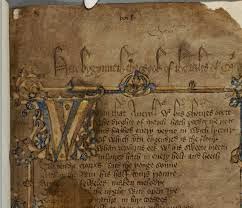In the first part of this research project I went over the major strands of inquiry concerned with ordering the Canterbury Tales, describing some of the problems encountered with different theories and methodologies.
I also briefly discussed the argument in favor of the Hengwrt and Ellesmere manuscripts. I will begin here stating that despite the many arguments against the Ellesmere ordering, and numerous disputes about its authenticity, its range of uses in anthologies/compilations/general texts speaks to its superiority as a text, if not to its authenticity of intention.
Going back to the idea of tale ordering, recall that the tales do not necessarily move around independently, but rather in groups, or fragments. This simplifies and complicates the process. If the tales move around in fragments, and there are reasons for tales to come in certain orders (i.e. Clerk after Wife), this effects the fragments altogether, moving them as units. Thus only a few relationships can determine how multiple tales move. The complicated part, however, is determining which tales comprise each fragment – something that can be done in two different ways which don’t always or necessarily work well together.
The first way is that of Manly and Rickert, analyzing every extant manuscript and finding the points of general consensus. If a majority of manuscripts depict a certain arrangement into a particular fragment, it makes it appear as though those tales belong together in a grouping. However, just because something is in the majority, does not make it right. The second option is to look at each tale individually and construct (or reconstruct) the fragments according to context. I think a combination of these two methods leads to some interesting results.
As previously mentioned, and sensible enough to where no explanation is needed, all of the manuscripts agree that the General Prologue is the beginning and the Retraction is at the end. N. F Blake asserts that this decision is indicative of a single trip, meaning the scribe(s) involved did not anticipate a return trip from Canterbury, and were certain that the Retraction marked an absolute end. I hate to have to disagree with Blake, especially considering his amazing scholarship in the area, but I have to disagree with one point. While, the Retraction does mark an absolute end, that does not absolutely exclude the idea of a return trip. Even though I am not necessarily a proponent of a return trip due to the small amount of tales we have to work with that hardly even conclude one trip, the Retraction does not (to me) imply that there was not a pre-ending, meaning that at one point along the way there could have been a sort of “conclusion” at Canterbury, followed by more tales, and ending in the Retraction as the finale, presumably back in London. Where this penultimate conclusion would have gone is hard to say, and whether any of the existing tales followed it is even harder.
Similarly, all manuscripts that have the Wife’s Prologue (not all 84 manuscripts include all of the tales) will contain a fragment that starts with it, and includes the Summoner’s and Friar’s tales respectively. These three are part of the larger marriage grouping of seven tales. In the Ellesmere, this is referred to as Fragment III, however, in other manuscripts, as shall be demonstrated, it moves around within the seven.
Note: Simply because the Ellesmere was considered the most authoritative manuscript for a number of years, even when particular manuscripts move the tales around, the numbering remains the same, and the fragments are placed “out of order.” The Ellesmere was considered the primary order and all others were variations. Thus when “Fragment III” is found in a different spot, it is still called “Fragment III.”
Manly and Rickert maintained that the tales were copied one at a time, but since they came out with their theory it has been stipulated that the fragments were copied in completed units, as unbroken series of tales and links that were left in that order by Chaucer, sufficiently clearly identified as complete units to never have been circulated in any other form. However, if you take into account the process of the scribe in between the Hengwrt and Ellesmere manuscripts, it becomes unquestionably clear that the order of Ellesmere, while preferable, is not the way in which the tales were acquired or originally linked. Why not and how so?
In order to understand the scribe’s physical process of constructing the Tales, parts of Chaucer’s intentions must be taken into account. While we cannot know for certain what he wanted to do, it is evident that he was trying to arrange the sequence of tales as link-tale-link-tale, with the prologues or end pieces of each teller serving as the links. Unfortunately, many of the tales had no links. If we are to accept the Hengwrt as the prototype manuscript (which I do), within this manuscript we can see that the precedent for the link-tale relationship had been set, and when links were unavailable, in expectation of their existence the scribe left spaces blank before each tale.
This is the order of a section of the tales in Hengwrt manuscript:
Wife of Bath Prologue and Tale
Friar
Summoner
Intro to Man of Law, his tale, and endlink
Squire
Merchant
Franklin
2nd Nun
Clerk’s Prologue, Clerk’s Tale, Envoy to the Clerk’s Tale
Physician
Pardon’er’s Prologue, Pardoner
Shipman
Prioress
Chaucer the Pilgrim, Prologue to Sir Thopas
Melibee
Monk
Nun’s Priest
Macniple’s Prologue, Manciple’s Tale
Parson’s Prologue, Parson’s Tale
Retraction
This is the order in which the Tales were written, meaning, when looking at the inks used, along with penmanship and quire marks, it reflects the order in which the tales were physically transcribed.
Merchant’s Tale
Franklin’s Tale
Nun’s Tale
Clerk’s Tale
Physician’s Tale and Pardoner’s Tale
Shipman’s Tale, Prioress’s Tale, Thopas, Melibee, Monk’s Tale, Nun’s Priest’s Tale
Merchant’s Tale
Wife of Bath, Friar, Summoner
Let’s look at the discrepancy between the Wife and the Clerk. There is a distinct mention of the Wife in the Clerk’s Tale (Envoy). The Clerk’s Tale was physically written first. The first implication here is that the scribe was copying mechanically, and the Hengwrt is not a premeditated manuscript. During the writing of the Clerk’s Tale the scribe does not understand the reference since the Wife’s Prologue has not yet come up. He continues copying until the end, where the Wife finally comes in as part of the last section. By that point it is far too late to reinsert her at an earlier point, so he finishes copying, and the manuscript’s quires are readjusted to move the entire fragment she is in to precede the Clerk. Yet this is a messy job.
Since the same principle scribe who completed the Hengwrt was responsible for the Ellesmere, he learned his lesson, and made the correct readjustments as he completed it, in the process changing the way fragments were arranged. Again, it is not individual tales that move, but entire groups. The Wife had to be before the Clerk. How far before is not determined, so the scribe places the fragment immediately before the Clerk’s Tale when constructing the Ellesmere. Hence the grouping the Wife is in is generally Fragment III, while the Clerk is the first in the sequence for Fragment IV. The second time around, there is no ink variation – after having copied the Hengwrt the scribe was sure enough of himself to write the Ellesmere in one edited stretch.
Note: manuscripts often took many years to complete because it was a painstaking, manual process. However multiple scribes worked on each manuscript in different capacities, so when I state the Ellesmere was written in one stretch, I am not implying it was one long uninterrupted stretch. Also, when I refer to a single hand, I am not referring to any artwork, lettering, or borders, which would not have been completed by the same scribe, copying the actual work. These things were added on later, which is often evident in places where room was left in the writing for intended pictures. And pictures will be important in this argument (only briefly) in a little bit, but my main concern is for the actual writing. Also, this statement does not take into account medieval devotional texts that were primarily picture based with only a few words in the margins, where it was obvious that the pictures were created first. The same scribal practices were not meant to be used across all genres of manuscripts.
Nevertheless, regardless of the order in which the tales were originally written in the Hengwrt (judged by the inks used), the fact that the tales maintain some sort of semblance of order means that even in the Hengwrt there was some original planning, as the final order of the tales places them in accordance to links and references, to a certain extent.
Yet in the Ellesmere there are more links than in the Hengwrts. Where did these come from, and why were some added while others not? No one argues that the Tales (with only a few notable exceptions) are Chaucerian, implying that links were found, meaning the scribe was correct in leaving blank spaces for these. They must have been found in between the creation of the manuscripts leading the scribe to completely abandon the Hengwrts and rework his plan for the Ellesmere before undertaking the project. Most likely, the spacing he left in Hengwrts was insufficient for some of the links he found (an assumption I make by looking at the space that was used in the Ellesmere and comparing it to the space originally left in the Hengwrt, which looks insufficient), and considering there is no break in the Ellesmere, he had everything he though he would ever have before he began writing it. Evidence of his complete abandonment of the Hengwrts lies in the artwork. The first page has the large capital lettering for which space was left, but none of the other fanfare attributed to medieval manuscripts is found on subsequent pages. The project was ended and it became a learning experience and rough draft for the Ellesmere.
Once the scribe realized that certain tales reference others that were not in the “correct” order (and I use quotes because I am hesitant to attribute that much authority to the Ellesmere at this point), groupings were rearranged. This is how Fragment III came to its current position, as it got moved up significantly. Yet even when rearranging the tales the scribe did not tare the Wife away from her grouping, moving the Friar and Summoner along with her, and placing the Clerk as closely following as possible.
In light of the Clerk’s Tale and Envoy, the Merchant, too, had to move to allow for all the weeping and wailing on account of Griselde. Once the Merchant moved, the links had to be adjusted to account for a repositioning of the Squire following the Merchant, followed by the Franklyn, as opposed to the Hengwrt where the Squire, Merchant, Franklin trio were higher up in the ordering. Thus Hengwrt’s “Quod the Merchant” as the Squire’s Tale is interrupted becomes Ellesmere’s “Quod the Frankeleyn.” This is clear scribal intervention to form coherence where the originals were ambiguous.
Unfortunately not all of the groupings are as stable as Fragment III (which is why I chose to begin with it). So, as the tales move in groups, or fragments, and any changes pertaining to one effects all, it is one of the best indications that the individual tales speak to each other, and can continue the discussion only when ordered properly.
This is all I have for now (at the end it will be evident why this must come piecemeal, which I suppose is appropriate considering the topic), and there will be more in the next couple of days.


